Where to keep bonsai trees in winter?
Outdoors
Some outdoor bonsai can stay without protection in winter while others do not. Your bonsai trees can survive outdoors in winter if;
- You live in a region where the temperature is almost always above freezing;
- You do not have much snowfall or frost;
- Your bonsai trees are cold-tolerant; and,
- They have grown enough roots during the growing season.
If one or more conditions are not met, they need to have some kind of protection in winter.
Can coniferous bonsai trees survive freeze?
You cannot leave your coniferous bonsai trees outside if their roots may freeze in the pots.
Coniferous trees such as juniper and spruce are very cold-tolerant as species and can easily survive sub-freezing temperatures. Coniferous bonsai trees are also cold-hardy but there is a catch. They can withstand cold as long as their roots are not frozen in the pot.
If the water in the pot doesn’t dry and freezes during the night, the roots may arise out of the pot, making it more prone to cold damage. And once damaged, roots are unable to regrow in winter and trees wither.
Cold-protection facility
Tree species that are susceptible to cold weather need some kind of protection. Those trees are;
- Trees that are grow in a warmer climate such as citrus trees (eg. oranges, lemons), azalea, tea trees and bamboo;
- Trees with fine branches such as Japanese maple, zelkova and ginkgo trees;
- Flowering trees that bloom in early spring such as winter plum trees; and,
- Flowering trees whose flower buds are easily damaged by low temperatures such as camellia.
Trees planted in the ground and in a bonsai pot react differently under different temperatures.
Even though the trees as species are quite cold-tolerant, their fine branches, especially at tips, can wither and die off under cold temperatures. These trees include Japanese maples and zelkova. Flower buds are more susceptible to frost damage when planted in tiny bonsai pots.
Sometimes special circumstances call for special care as well. These cases include;
- The region where it snows so heavily that the snow might break the branches;
- Trees recently repotted and not yet fully rooted;
- Trees weakened for infestation, hard pruning, etc.;
- Trees stressed from tightly wired for styling;
- Trees planted in smaller pots compared to their size; and,
- Bonsai trees of smaller sizes (i.e. mini bonsai).
These trees are more susceptible to cold weather than other bonsai trees.
Can you keep your tree inside the house?
Bonsai trees cannot be moved inside the house where the rooms are heated, except for some indoor bonsai species such as ficus and jade. If the trees are kept in a very warm place, they will not be able to go dormant, which will adversely affect the next year’s sprouting and subsequent growth.
Do bonsai need greenhouse?
Your bonsai trees need a greenhouse or other cold protection facility in winter if it snows and the temperature gets below freezing for a few weeks, and the trees are not cold-tolerant. They need to be protected from winter winds, rain and snow.
What type of greenhouse
Material/Structure
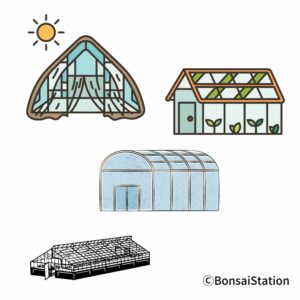
There are several types of greenhouses according to shapes and structures but bonsai trees do not need a very high-tech, fully-automated facility as long as they are protected from freezing winds and heavy snow.
The material of a bonsai greenhouse can be glass or plastic/polyethylene-covered depending on how much you can spend and how cold the climate is. Glass greenhouse is expensive though it can last very long. A simple plastic greenhouse is cheaper but would not keep the bonsai trees from cold after sundown without any insulation.
Depending on the region, it may be necessary to add extra heat to your greenhouse. A bigger greenhouse is better in this aspect because it can keep warm air during the nighttime compared to a smaller one.
Cold frame
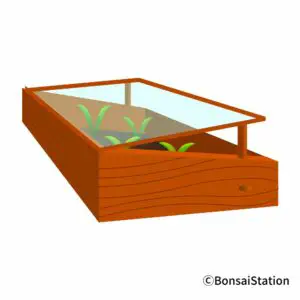
cold frame
A half-buried cold frame can be a good choice when the climate is not that cold.
Because a cold frame is a relatively small structure, the temperature inside a cold frame generally is not more than 5 to 10 degrees F above the outside temperature. A cold frame half buried in the ground can keep the warmth longer than the usual one at night as the ground around it act as insulation.
Temperature
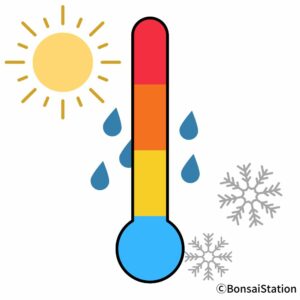
Any type of cold protection facility will do for a bonsai greenhouse but the difference in temperature between day and night should be as small as possible. Be extra careful if you have a small greenhouse because the temperature inside tends to get hot during the day and cold at night than in large greenhouses.
The average temperature inside the greenhouse should be between 45°F to 60°F (7°C to 15°C). Depending on the climate and where you place the greenhouse, you might need insulation to balance the temperature.
Temperatures above 70°F (20°C) are harmful to bonsai trees in winter. If the temperature is too warm during dormancy, they may bloom or may sprout too early and damage the buds in the cold. You need to ventilate the greenhouse to lower the temperature when the temperature inside the greenhouse rises above this level on a sunny day.
When to put
The basic rule of winter protection for bonsai is to put it in the greenhouse late and take it out of the greenhouse early.
When the temperature below 40°F (5°C) continued for a few days in late fall, it is time to put your bonsai trees in the greenhouse. It depends on the region where you live, of course, but it should be around November.
But you should not be too hasty moving bonsai trees into the greenhouse only because they are particularly sensitive to cold. Make sure that they get frost 2 to 3 times before housing in the greenhouse.
This is because the frosts allow the bonsai trees to experience the beginning of winter, which prepares them to be cold hardy for the coming cold months. They are more susceptible to the chilly climate if you put them in a warm greenhouse without experiencing the cold weather for a few days.
As to the bonsai tree species that originated from warm climates such as citrus fruit bonsai trees, they need to be protected from the cold about a month earlier than others. Artificial heating may be required inside the greenhouse for those trees, especially in cold climates.
Where to put
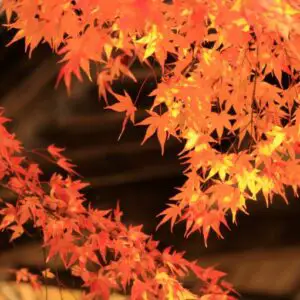
Deciduous bonsai tree species such as Japanese maples, ginkgo, and zelkova trees go dormant in winter. During dormancy, they do not produce energy through photosynthesis. Those dormant bonsai trees do not need much sunlight and can be kept in shaded areas inside the greenhouse.
On the other hand, early-blooming flowering trees such as plums, cherry blossoms, and mandarin oranges require sunlight even in winter because the changes in the length of the daytime, as well as temperature, trigger flowering. As such, they should be placed in a sunny location on the south side of the greenhouse.
Evergreens such as cypress and juniper do photosynthesize in winter, though at a much slower pace. It is a good idea to get them sunlight during the day. That said, they can be kept in the shade until spring which usually does not have a negative effect on their growth.
Watering

Watering is less necessary in winter than during the growing season as bonsai consumes less water. That said, bonsai trees, regardless of species, need water in winter. Even under low temperatures, the dry winter air can unexpectedly deplete the moisture from the soil.
Water thoroughly when the surface of the soil is dry. Normally, trees placed in a greenhouse should be watered once every 3 to 5 days. For evergreens that are active even in winter, check the soil once a day and water them when it is dry.
Water should be given early in the morning to let it drain and dry during the day so that no excess water is left over at night. If the soil is too wet after sundown, the moisture in the soil may freeze and damage the roots. If the soil does not thaw the next day, the roots of even hardy tree species will be damaged.
Make sure to ventilate when the humidity inside the greenhouse gets too high.
When to take out
Basically, you can take the bonsai trees out of the greenhouse when the weather warms up in the spring and the frost damage is no longer an issue. Having that said, you cannot suddenly take them out of the greenhouse one day and place them outside. Instead, you need to slowly acclimate the trees to the outside air.
In early spring, open the door of the greenhouse during the day to expose the trees to the outside air, and close the door at night to keep them warm and protected.
When the climate gets warm enough, take the trees outside during the day and bring them back inside the greenhouse at night with the door half open. This is to slowly get them used to the cold air at night. Do not leave the door fully open to prevent them from getting frost and cold winds that damage new shoots.
You can put your bonsai trees out completely when there is no concern about late frost.
If you are interested in knowing more about bonsai spring care, the following post might be helpful.
Fertilizer and pest control
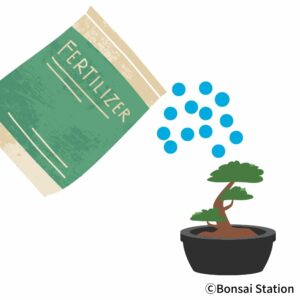
Fertilizers are not required for bonsai trees during the winter.
Garden trees are sometimes fertilized during winter to give nutrients to their roots, which continue to grow slowly despite dormancy. Winter fertilization is, however, not necessary for bonsai. The amount of fertilizer needed for root growth is quite little and its excess is harmful rather than beneficial.
When bonsai trees are infested with aphids, which can happen in the greenhouse, you need to disinfect them with insecticide.
Other bonsai winter protection
If you live in a region where you do not need a greenhouse to protect your bonsai trees but still need some kind of protection, here are some of the options you can consider.
Move to a warmer place
You can move your bonsai trees to a warmer place such as under the front porch where they are protected from the cold wind. You can cover them with a plant cover when the weather is particularly cold.
The tips of the branches of mini bonsai trees can be easily damaged by cold and dry wind. If that is the case, make a windshield from the angle the wind is blowing without blocking the sunlight.
Under the bonsai shelf
You can use the shelf for winter protection if you usually keep your bonsai on it. Move your trees under the shelf and cover every side of the shelf except for the south side to protect them from the cold.
Bury pots in the ground
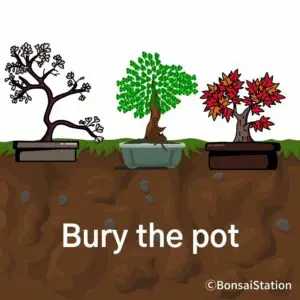
You can bury the pots in sunny, well-drained ground if you do not have much snowfall. The pots should be buried at the height of the pots. Add mulch to protect the roots. When it is cold, cover the trees with plant cover.
Make sure to water your trees at the same frequency as they are on the shelves because your trees cannot absorb water from the ground through the small drainage holes in the pots.



